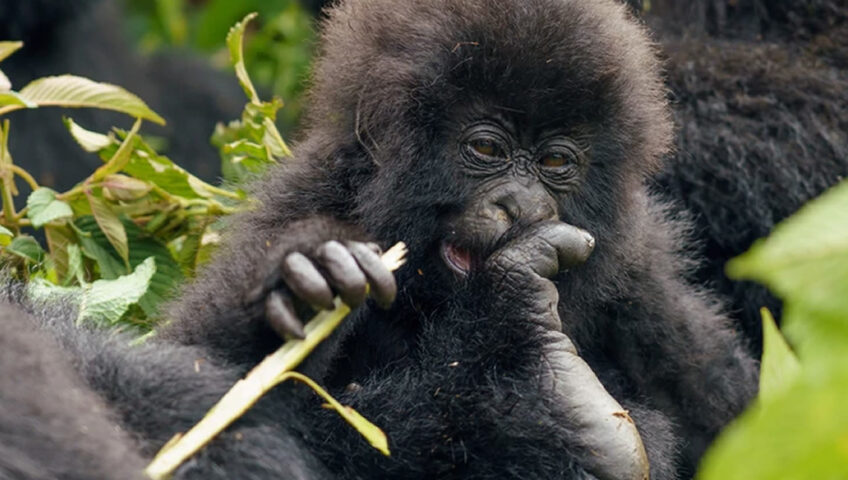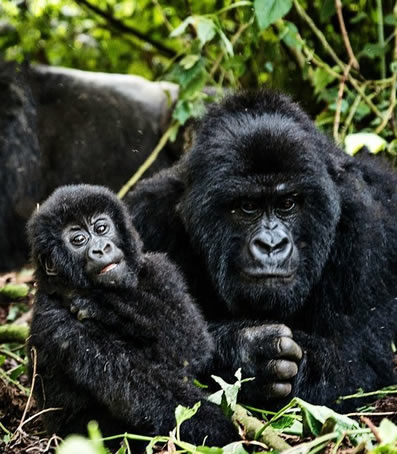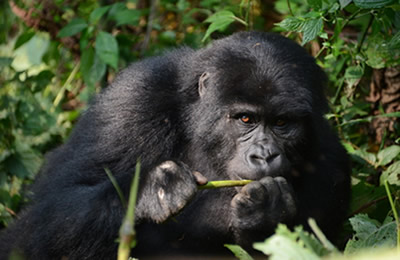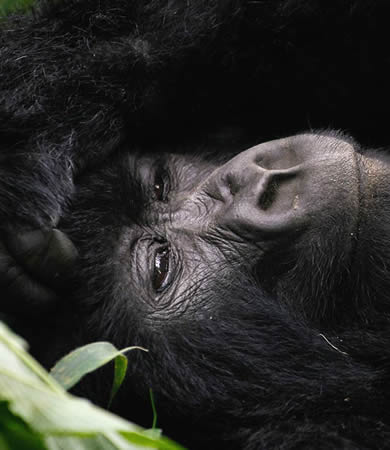
Facts About Gorillas

Gorillas are unique endangered species whose population is growing due to tourism. Tours to the gorillas help to raise funds for conservation works. These great apes occupy some of the rainforest dominated areas in Africa in East and Central Africa. They come with features worth exploring on actual gorilla trekking adventure. In this article, we have put together some of the most amazing facts about gorillas;
-
Facts About Gorillas
Gorillas are the biggest of the great apes. A fully grown up male gorillas are bigger than females. An adult male gorillas can weigh between 300 and 500 pounds. When standing, a mature male gorilla can rise 6ft tall. The female gorilla weighs between 1500 and 200 pounds and can stand up to 4.5 feet tall. In short, the size of these apes does differ depending on the species and sex. In terms of strength, gorillas are estimated to be 10 times stronger than humans.
-
Closeness to humans
Gorillas aren’t just huge but also share a lot in common with us humans. Over 98.3% of gorilla DNA is same to that of humans and they come second after chimpanzees and bonobos as human closest relatives in the wild.
Gorillas like humans groom their young ones and in an event of death gorillas check on the dead individual and mourn for the individual.
Species in the wild –there are only 2 gorilla species to explore in the wild. They include Eastern and Western gorilla. The two species are further sub-divided forming a total of 4 sub-species of gorillas. The Eastern gorilla sub-species comprise of Eastern mountain gorillas and Eastern lowland gorillas. The Western gorilla species forms the Western lowland gorillas and the Western cross-river gorillas. They have a life span of 40 t0 50 years.
-
Social life
Gorillas like humans are organized in family groups also referred to as troops. In average, about 5-10 gorillas and up to 50 individuals can live in one group. They are polygamous where one dominant male (silverback) takes responsibility to mate the females in the group. The young keep within the troop till they become mature and to prevent inbreeding, these apes often move to new troops.
Gorillas are shy and avoid direct eye contact also emotional in nature. They can express themselves using different emotions including grieving and laughing. They have different ways to communicate to with each other including chuckles, whines, strong-grunts, whimpers, shouts, cries, screams, chest beating and more.
These apes are highly intelligent –they can use different tools to perform certain tasks including sticks to measure the depth of river. Twigs for scooping food material and ladders from bamboo for their young ones to climb the tree.
-
Feeding habits.
gorilla diet is composed largely of vegetation products. They feed on fruits, tree backs, leaves, and other succulent materials.
-
Status
The survival of these great apes has been greatly impacted by a number of factors including poaching, invasive diseases, human interference through agriculture, habitat loss, wars and more.
-
Where to find gorillas

Gorillas are wide spread across Africa. They occupy African countries such as Uganda, Rwanda and D.R. Congo (the best place to trace the Eastern gorillas); the Central African Republic, Equatorial Guinea, Angola, D.R.C, Gabon, Cameroon, Nigeria –where Western gorillas live.
These apes live in natural rainforests and build nests each day for a night stay. Gorillas live above 1400 meter elevation and their habitat may comprise bamboo forest, sub-alpine grassland, mixed forests and more.
-
Life cycle
Female gorillas can become sexually mature when they reach 7-8 years. The male counterparts become sexually mature at 15 years.
-
Life expectancy
In the wild, gorillas can live up to 50 years. Gorillas behave in the manner that females can leave a group at maturity stage and join another family or the single male gorilla to begin a new group. The practice plays a significant role in preventing inbreeding among these apes.
-
Movement.
Gorillas walk by knuckling –they use all the 4 limbs and can stand upright.
-
Differentiation
Each gorilla features a distinct nose print, a unique factor that differentiates these apes from each other.
-
Places to go for gorilla trekking
Get the best of gorilla trekking experience in any of the 4 National Parks; Bwindi Impenetrable National Park & Mgahinga Gorilla National Park in Southwestern Uganda. These 2 parks feature 5 sectors –Buhoma, Nkuringo, Rushaga and Buhoma in Bwindi, Ntebeko in Mgahinga.
In the D.R. Congo, visit Kahuzi-Biega National Park to interact with the habituated eastern lowland gorilla family (5 groups are all open for tourism here) and explore mountain gorillas in Virunga National Park with 8 habituated families.
While in Rwanda, visit Volcanoes National Park in Ruhengeri where 12 habituated mountain gorilla families peacefully live. This park is the most accessible among the gorilla parks where visitors spends only 2-3 hours to drive from the heart of Kigali.
